At my flower farm in St. Louis, Missouri, I grow more than 150 varieties of flowers exclusively from seed. I know that sounds strange in an era where many flower farmers get product to market faster by ordering plug plants, but I personally love the whole cycle of growing. It takes longer, but I really enjoy watching my plants grow, evaluating the strengths and weaknesses of different varieties or seed stock, and all the opportunities to learn something new in the entirety of the process. Also, because secretly I’m a science nerd. You’re about to see why.
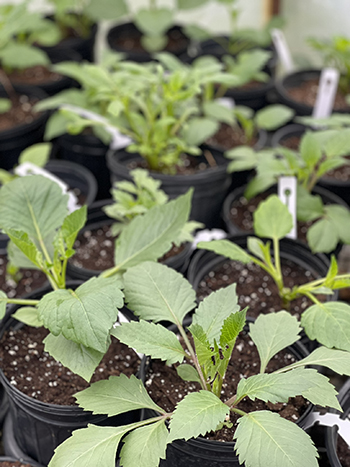
Floret and Hambor dahlias from seed in March 2024. All images courtesy of the author
In addition to the seed crops, I grow dahlias. I know, I know. Everybody loves dahlias. I’m in good company, but my devotion is perhaps from a different angle than most. Yes, they are beautiful, come in so many colors, shapes and sizes, but my fascination is in their genetics.
Most flowers, like animals (including humans), have two sets of genes. Dahlias have eight sets of genes. This radically different genetic configuration means that when you save seeds from open-pollinated plants the seeds produce a genetic rainbow lottery. Additionally, all the seeds from the same flower are genetically unique, meaning if you saved 50 seeds from one dried flower head, that too produces infinite combined possibilities.
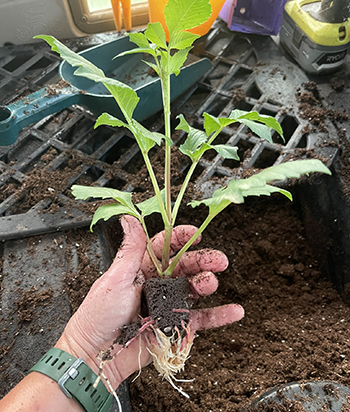
Pinchling roots after two weeks.
Debunking conventional wisdom
Conventional wisdom purports three ways to propagate dahlias.
Tubers: By saving and dividing, storing and replanting a specific tuber, it will come back true to type as a genetic duplicate of the plant the tuber produced the previous growing season. Repeat the same process year after year to keep the same dahlia.
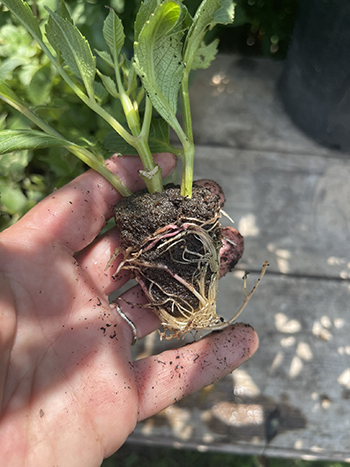
Pinchlings showing early tuber development.
Seeds: This is the genetic lottery previously mentioned. Growing dahlias from seed is easy and fun, waiting to see what the individual seeds produce in terms of color, shape, size and form. When a flower is produced, if you like it, you can dig up the tuber at the end of the season and grow it again to produce the exact same flower.
Cuttings: Many people make ‘cutting beds’ with tubers laid in shallow planting trays. As the tubers send up shoots, they are cut off from the tuber, to be grown as a cutting, and then a full plant of the exact variety as the parent tuber. This isn’t an infinite process because eventually that main tuber energy will be spent. This is the method that dahlia hybridizer Kristine Albrecht of Santa Cruz Dahlias uses and teaches.

Pinchling planted out.
I want to pause the elaboration on dahlia propagation to share some of my experiential context. As every year we seem to break the previous year’s heat records, Midwest ‘Spring’ has become a soggier version of Midwest ‘Summer.’ We’ve had huge deluges of rain, sometimes getting 8 inches in a 24-hour period, which has been a bonus for most of the non-dahlia varieties. So much hydrostatic soil pressure wrecks havoc on dahlia tubers.
Combined with excessive heat, many flower farms like us have lost hundreds or thousands of tubers already this year. Dahlia tubers, no matter who you source them from, can be quite an investment. Especially when you’re not buying at wholesale prices, but instead paying a premium to grow out more exotic and sought after form and color combinations for event work. Here alone, we lost hundreds of tubers. It was heartbreaking, but I had taken out a science geek ‘insurance policy’ beginning in March of this year. Let me explain.
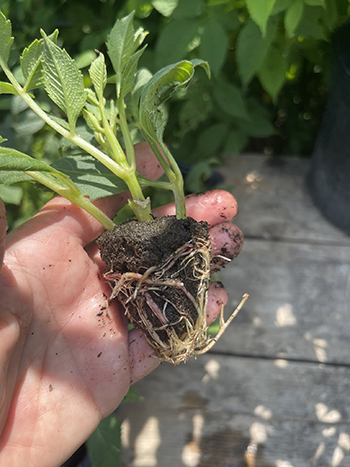
Composite dahlia plug from pinched center and two different branch varieties.
My dahlia mentors are Albrecht, Erin Benzekien (Floret Flower Farm) and John Hambor (genetic sequencer). Hambor’s and my shared love of dahlias made planning and creating floral for his daughter’s wedding one of the most informational growing experiences you’ll never have in the wedding industry.
This year, I’m growing dahlia varieties from all three sources — seeds, tubers and rooted cuttings. All dahlia growing instructions include a process called ‘pinching.’ Pinching is removing the central stem of the young plant after it’s around 10 inches tall and has at least four sets of leaves. Whether you cut or just pinch off this central stem and discard it, it signals the plant to redirect its energy to the lateral buds to stimulate growth to produce a bushier plant, thus producing more flowers. I do not do this. Here’s what I do instead:
I wake my tubers up in March, in a hoophouse to keep them from dropping below 52°F. I pot them up and begin growing them in pots with plenty of room to expand. When they are eligible for pinching, instead of cutting and discarding, I take that cut piece, dip it in rooting hormone, plug it into a root riot cube, and put that in a 72-cell tray with a solid tray of water underneath. I keep all of the cubes moist and keep them in less than full sun for about two weeks (sometimes three).
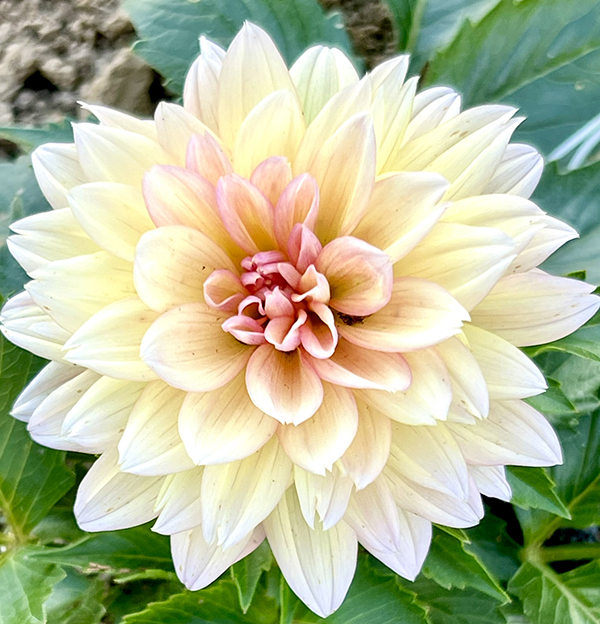
Revived dahlia stem became new plant.
They are noticeably ready for being transferred to soil and pot when you can see visible roots lifting the root riot cube up from the edge of the tray cells. That formerly discarded pinched center, is now it’s own rooted dahlia ready to be potted up on it’s own. I call them ‘pinchlings.’
Here’s where it gets crazy. This year alone, I took the tops of all of my dahlia plants and made entirely new plants. In addition to that, as those plants grew and began developing their own tubers and grew in height, I pinched them again and made a second-generation carbon copy of the plant.
What is even crazier, is that both the first and second generation of my cloned ‘pinchlings’ plants grew faster, taller, and produced flowers faster than their tuber parent. At the time of writing this article, I am on my 9th and 10th generations.
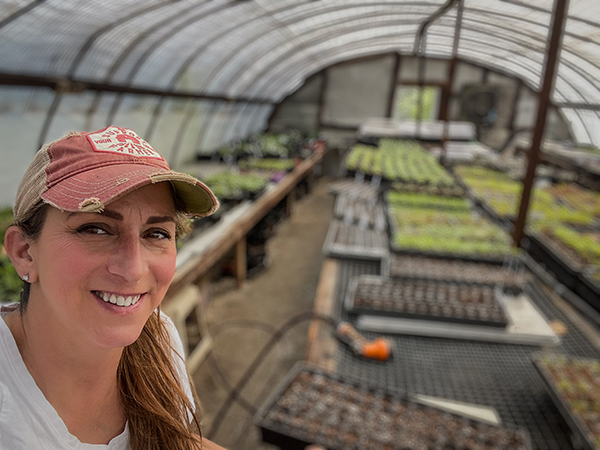
The author in the hoophouse making Pinchlings March 2024.
Ever curious to expand my understanding of my plants, I also removed dahlia leaf sets to try to root them. Insanely, they not only produce roots, they also create a new central stem. I even have taken almost dead dahlia shoots from a friend who ordered tubers the previous year and never opened the box, and cut the pale white, green shoots into ½ inch sections and repeated the process with rooting hormone and root riot cubes. It not only revived the segments, but also went on to produce a whole new plant five times over from all the successfully regrown sections.
I’ve even made a composite plant by rooting a pinched center in the same cube as two different branch varieties to grow three different dahlia flowers from the same plant.
What is most important from all my trials and recorded data is that the traditional conventional wisdom about how dahlias grow, is in fact, not entirely correct. Sure pinching changes the way the tubered plant grows and creates more branching, but that pinched central stem (that has been discarded for years) has more immediately usable energy than it’s parent. Throwing it on the ground was wasted energy and a missed opportunity to create more plants from your dahlia stock.

Strawberry Fields dahlia pinchling whose parent tuber was lost.
Now you understand why when the majority of my tubered dahlia crop failed, I had plenty more backup plants that did not. And, because the water-logged tubers were prone to rot with saturated ground, the young dahlia pinchlings did not suffer the same fate because they began as root-based plants and are still making their tubers and able to draw water and nutrients through a predominantly root-based support system.
Out in the field, the pinchlings are tall and gorgeous plants. To look at them, you would never know they were in any way different from what you would expect. They are lush and vibrant, well branched and producing beautiful blooms exactly like their parents would have. The rows of the tubers I planted is a ghost town by comparison. But as I said here in the beginning, in this particular year, my different approach has made all the difference in the world.
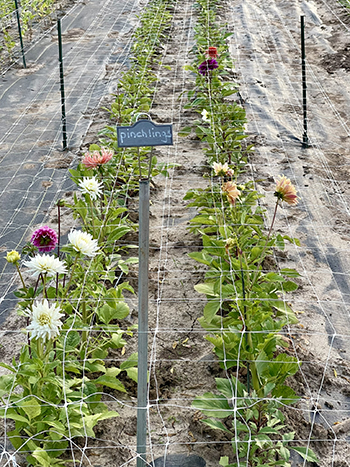
A row of pinchlings.
I wanted to share this information and my findings with you as fellow farmers and growers because it will give you the same insurance policy that it gave me this year. Changing the way we think about dahlia plants’ energy allows us the flexibility to grow more plants; protect our variety genetics; and for dahlia hybridizers and breeders, a much faster track to scale up production of a new variety to increase stock or get it to market faster.
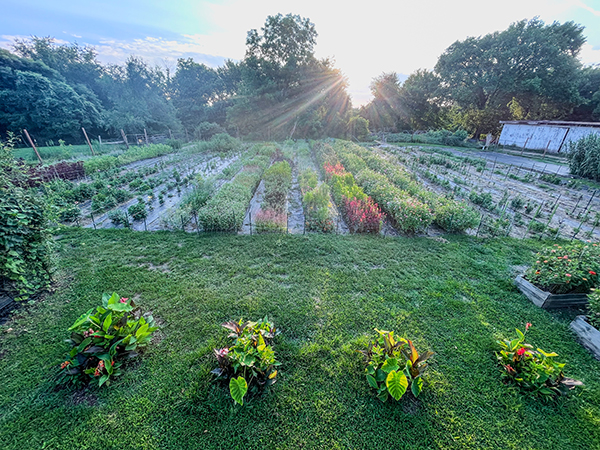
Queen Bee Blooms.
It is ever on our minds that as our climate becomes increasingly unpredictable, any tool or resource that allows us to adapt or anticipate change, is worth sharing. I sincerely welcome your feedback, and the opportunity to help you along the way if this is a practice that interests you in your dahlia growing plan. Being a farmer has always been to stand on the shoulders of those who came before, and I’m here to do my part as we move towards more adaptable growing seasons.
If you would like more information, photos during the process, data and suggestions to duplicate my results, don’t hesitate to reach out. I’m happy to help.
Elizabeth Fichter is expanding propagation boundaries with nerdy floral science at Queen Bee Blooms Flower Farm in Saint Louis, Missouri. You can find her online at queenbeeblooms.com and on Instagram @queenbeeblooms and on Facebook.

